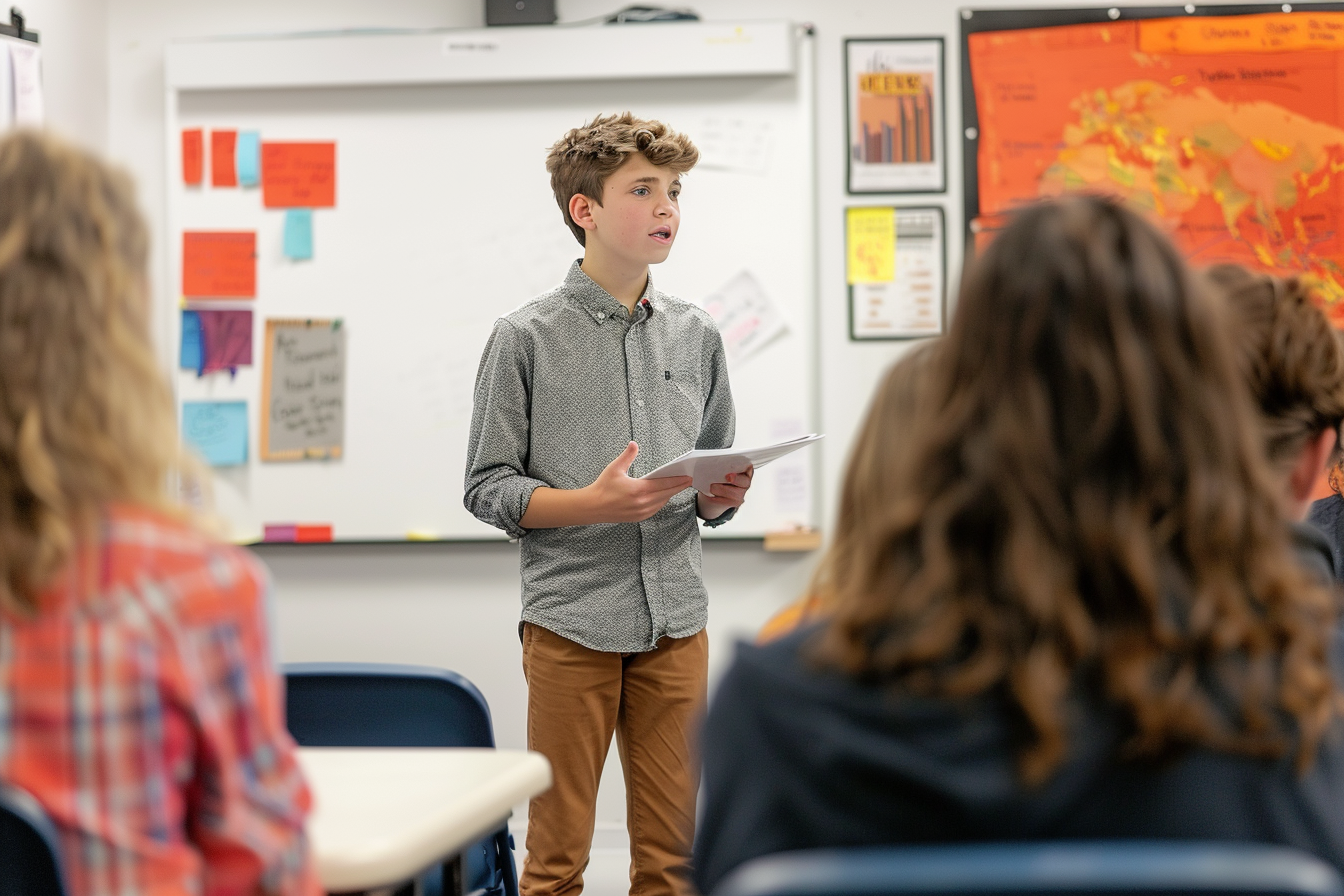Empowering Teachers with Student-Led Professional Development
Discover how student-led professional development boosts teaching, engagement, and collaboration through feedback, co-teaching, and tech.

Imagine a classroom where students actively contribute to shaping the way they are taught, providing valuable insights that help teachers improve their instructional methods. Student-led professional development is turning this vision into reality by placing students at the heart of teacher training. This innovative approach leverages the unique perspectives of students to create a more dynamic and engaging learning environment for everyone involved.
As the landscape of education continues to evolve, the need for more responsive and effective teaching practices has never been greater. Traditional professional development often misses the mark by not including the voices of those who experience the teaching first-hand: the students. Incorporating student feedback into teacher training ensures that educational strategies are grounded in real classroom experiences and address the actual needs of learners.
We will explore the principles, benefits, and implementation strategies of student-led professional development, highlighting how it can transform classrooms and foster a culture of collaboration and continuous improvement. Join us as we delve into this groundbreaking approach that empowers both teachers and students to reach their full potential.
Understanding Student-Led Professional Development
Student-led professional development involves incorporating student perspectives and feedback into teacher training and instructional improvement. This approach emphasizes the importance of student voice in shaping effective teaching practices and fostering a collaborative learning environment. By actively involving students in the professional development process, educators gain valuable insights into their teaching methods and how they impact student engagement and learning.
The concept of student-led professional development has evolved alongside the increasing recognition of student agency in education. Historically, professional development for teachers has focused primarily on expert-led workshops and top-down initiatives. However, there is a growing movement towards incorporating student feedback to create more responsive and dynamic teaching practices.
Enjoy science fiction? Check out my space books HERE on Amazon!
Core principles of student-led professional development include student voice, collaboration, and continuous improvement. By integrating these principles, schools can create a culture of mutual respect and shared responsibility for the learning process, ultimately leading to better outcomes for both teachers and students.
Types of Student-Led Professional Development Models
Student-led professional development can take various forms, each offering unique benefits and opportunities for growth. Here are some common types:
- Student Panels and Feedback Sessions: In these sessions, students provide feedback on teaching practices and classroom experiences. This direct communication helps teachers understand student perspectives and make informed adjustments to their methods.
- Student-Led Workshops: Students design and lead workshops on topics relevant to teaching and learning. These workshops allow students to share their insights and expertise, fostering a collaborative learning environment.
- Co-Teaching Models: Students and teachers collaborate to design and deliver lessons, sharing insights and feedback. This model promotes mutual learning and respect, as both parties contribute to the teaching process.
- Student Observations and Reflection: Students observe classes and provide reflective feedback to teachers. This approach allows students to articulate their learning experiences and helps teachers refine their practices based on student observations.
- Project-Based Collaboration: Students and teachers work together on projects that improve teaching and learning. These collaborative efforts encourage creativity, problem-solving, and innovation in the classroom.
By exploring these types of student-led professional development, schools can find models that best suit their educational goals and community needs.
Benefits of Student-Led Professional Development
Student-led professional development offers numerous advantages that make it a valuable approach for schools. Here are some key benefits:
- Enhanced Teaching Practices: Teachers gain direct insights from students to improve their instructional methods, leading to more effective teaching.
- Increased Student Engagement: Students feel valued and heard, which boosts their motivation and participation in the learning process.
- Stronger Teacher-Student Relationships: Collaboration fosters mutual respect and understanding, strengthening the relationships between teachers and students.
- Continuous Improvement: Regular feedback from students helps teachers continually refine their practices, promoting a culture of ongoing development.
- Real-World Learning Opportunities: Students develop skills in leadership, communication, and critical thinking by participating in professional development activities.
These benefits highlight the potential of student-led professional development to create a more responsive and effective educational environment. By understanding these advantages, educators and administrators can better appreciate the value of incorporating student perspectives into professional development initiatives.
Implementing Student-Led Professional Development
Implementing student-led professional development requires careful planning and collaboration. The first step is developing a clear framework and objectives for the initiatives. This involves defining the goals, identifying the participants, and outlining the activities that will take place. Involving educators, students, and administrators in this process ensures that the initiatives meet the needs and values of all stakeholders.
Teacher training and preparation are crucial. Ensuring that teachers are ready to collaborate with students and value their input is essential for the success of the program. Providing professional development on how to facilitate student-led activities and integrate feedback into teaching practices can help build teacher confidence and buy-in.
Student selection and training are also important. Identifying students who are interested and capable of participating in these initiatives and providing them with the necessary training helps ensure their effectiveness. This may include training on how to give constructive feedback, lead workshops, and collaborate with teachers.
Scheduling and logistics need to be carefully planned. Organizing sessions, workshops, and meetings to fit within the school schedule helps ensure that the initiatives are sustainable and do not disrupt regular teaching and learning activities.
Finally, feedback and evaluation are critical. Continuously assessing the effectiveness of the initiatives and making adjustments as needed helps ensure their success and sustainability.
Overcoming Challenges in Student-Led Professional Development
Implementing student-led professional development comes with its own set of challenges, but these can be effectively managed with strategic planning and collaboration. One major challenge is teacher resistance. Addressing concerns and building buy-in among educators requires clear communication about the benefits of student-led initiatives and involving teachers in the planning process.
Student preparation is another challenge. Ensuring students are adequately prepared and confident in their roles requires thorough training and ongoing support. This helps students feel empowered and capable of contributing effectively.
Balancing power dynamics is crucial. Maintaining a respectful and productive teacher-student relationship requires careful facilitation and clear guidelines to ensure that both parties feel valued and heard.
Time constraints can also be a barrier. Finding time within the school schedule for additional professional development activities requires careful planning and prioritization. Flexibility and creativity in scheduling can help overcome this challenge.
By addressing these challenges, schools can successfully implement student-led professional development initiatives that benefit both teachers and students.
Case Studies
Implementing student-led professional development has led to notable successes in various educational settings across the country. Here are three case studies highlighting the impact of these methods:
Case Study 1: Student Feedback Panels in a California High School
A high school in California implemented student feedback panels where students provided insights on teaching practices and classroom experiences. Teachers reported improved instructional methods and increased student engagement as a result of the feedback. The school saw higher student satisfaction and academic performance.
Case Study 2: Co-Teaching Initiatives in a Texas Middle School
A middle school in Texas adopted co-teaching initiatives where students and teachers collaborated on lesson planning and delivery. This approach fostered mutual respect and understanding, leading to more dynamic and effective lessons. Teachers appreciated the fresh perspectives, and students felt more invested in their learning.
Case Study 3: Student-Led Workshops in a New York Elementary School
An elementary school in New York introduced student-led workshops on various topics, including technology use and creative writing. Students designed and facilitated the workshops, sharing their knowledge and skills with teachers. This initiative enhanced the learning environment, with teachers gaining new strategies and students developing leadership and communication skills.
Practical Tips for Educators and Administrators
Implementing student-led professional development can be straightforward with the right approach. Here are some practical tips for educators and administrators to consider:
- Start Small: Begin with pilot programs and gradually expand to build confidence and demonstrate success.
- Create a Safe Environment: Ensure a supportive atmosphere where students feel comfortable sharing their insights and teachers feel valued.
- Encourage Open Communication: Foster an open dialogue between teachers and students to build trust and understanding.
- Provide Ongoing Support: Offer continuous training and resources for both teachers and students to ensure their success.
- Celebrate Successes: Recognize and celebrate the achievements and contributions of students and teachers to build momentum and motivation.
These tips can help educators and administrators create a successful and sustainable student-led professional development program that benefits both teachers and students.
Future Trends in Professional Development
The future of professional development is evolving, with new trends enhancing its effectiveness and reach. Increased student involvement is a growing trend, with more schools recognizing the value of student insights in shaping effective teaching practices. This shift towards incorporating student perspectives reflects a broader movement towards student agency in education.
Technological integration is also becoming more prevalent. Using digital tools to facilitate student-teacher collaboration and feedback can enhance the effectiveness of professional development initiatives. Online platforms, video conferencing, and collaborative software can make it easier to implement student-led activities.
Check out our engaging printable posters. CLICK HERE to explore!
Global perspectives are another emerging trend. Connecting with student-led initiatives worldwide for shared learning and inspiration can broaden the scope of professional development and introduce new ideas and practices.
Data-driven approaches are also gaining traction. Leveraging data to tailor professional development to specific needs and goals can enhance its effectiveness and ensure continuous improvement.
By staying updated with these trends, schools can continue to innovate and provide high-quality professional development for teachers.
Conclusion
Student-led professional development represents a transformative approach to enhancing education by incorporating student insights into teacher training. By embracing models such as student feedback panels, co-teaching, and student-led workshops, schools can create a more responsive and dynamic learning environment. These initiatives foster stronger teacher-student relationships, increase student engagement, and lead to continuous improvement in teaching practices.
As education evolves, it is crucial to address challenges such as teacher resistance, student preparation, and time constraints. By overcoming these barriers and staying attuned to future trends like technological integration and equity-focused approaches, schools can successfully implement student-led professional development. This approach not only benefits teachers and students but also promotes a culture of collaboration, respect, and shared responsibility for educational excellence.
Check out some of my latest science fiction books HERE on Amazon!
Transform your classroom into an inspiring and vibrant learning space with our beautifully designed printable posters! Perfect for engaging your students and enhancing your teaching environment, our poster bundles cover everything from historical philosophers to animals. CLICK HERE to explore our exclusive collections on Teachers Pay Teachers and give your students the motivational boost they need!
